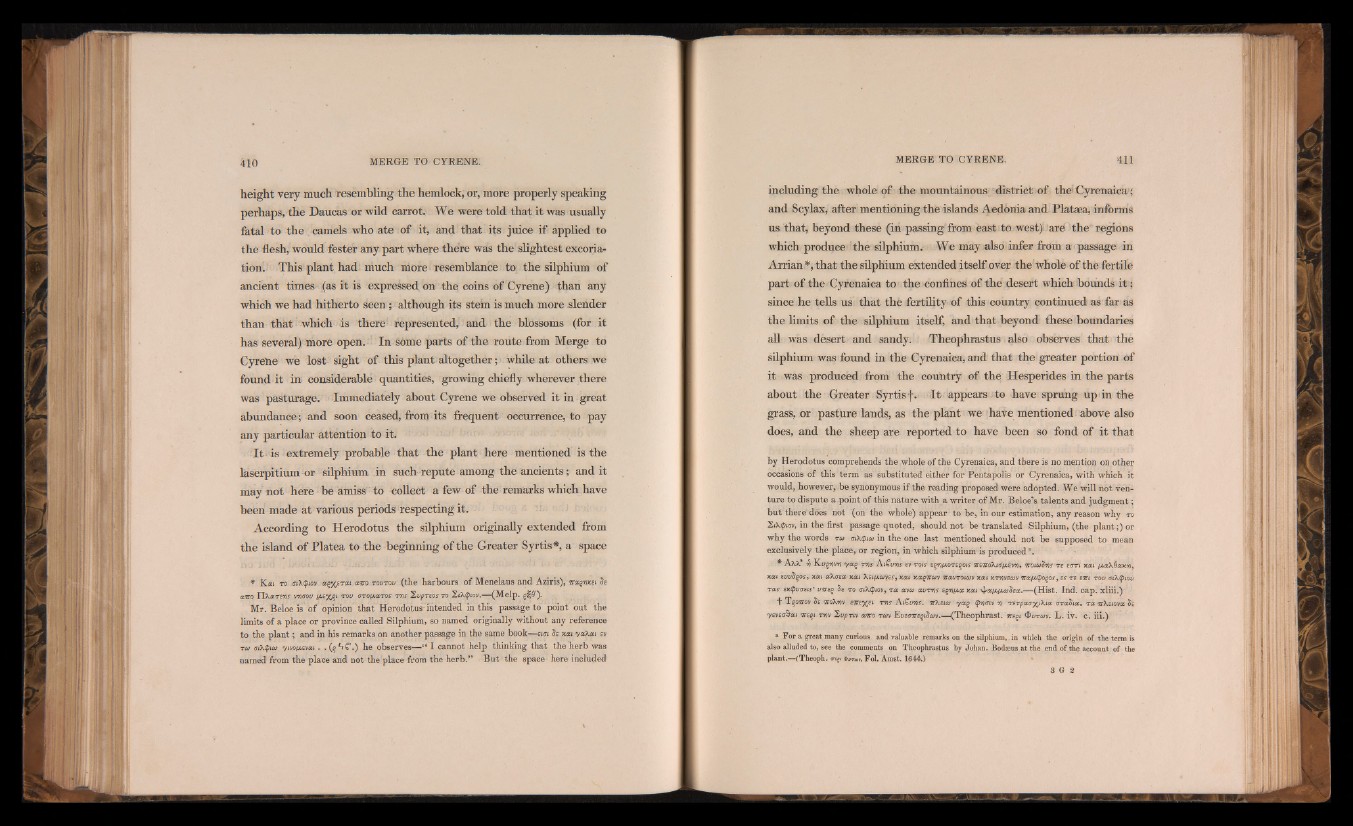
height very much Tesembling the hemlock, or, more properly speaking
perhaps, the Daucas or wild carrot. We were told that it was usually
fatal to the camels who ate of it, and that its juice if applied to
the flesh, would fester any part where there was the slightest excoriation.
This plant had much more resemblance to the silphium of
ancient times (as it is expressed on the coins of Cyrene) than any
which we had hitherto seen; although its stein is much more slender
than that which is there represented, and the blossoms (for it
has several) more open. In some parts of the route from Merge to
Cyrene we lost sight of this plant altogether; while at others we
found it in. considerable quantities, growing chiefly wherever there
was pasturage. Immediately about Cyrene we observed it in great
abundance; and soon ceased, from its frequent occurrence, to pay
any particular attention to it.
I t is extremely probable that the plant here mentioned is the
laserpitium or silphium in such repute among the ancients; and it
may not here be amiss to collect a few of the remarks which have
been made at various periods respecting it.
According to Herodotus the silphium originally extended from
the island of Platea to the beginning of the Greater Syrtis*, a space
* Kai to ^¿aS.cv ttto tovtov .(the harbours of Menelaus and Aziris), irccgnxei Se
k oto IIXiETeur wimu iAE%gi rou t t® £w e to t rz r St/gTeor To YiXpiov.— (Melp.
Mr. Beloe is of opinion that Herodotus intended in this passage to point out the
limits of a place or province called Silphium, so named originally without any reference
to the p la n t; and in his remarks on another passage in the same book—sim h kxl yxKai ev
t s yivoy.Evai. . (g bC.) he observes—. I cannot help thinking that the nerb was
named from the place and not the place from the herb.” But the gpace here included
including the whole of the mountainous; district of the¡ Cyrenaica;
and Scylax, after mentioning the islands Aedónia and Platsea, informs
us that, beyond these (in passing from east to west) are the regions
which produce the silphium, We may also infer from a passage in
Arrian ,*, that the silphium extended itself over the whole of the fertile
part of the-Cyrenaica to the confines of the desert which bounds i t ;
since he tells us that the fertility, of this country continued as far as
the limits of the silphium itself and that beyond these boundaries
all was desert and sandy. Theophrastus also observes that the
silphium was found in the Cyrenaica, and that the greater portion of
it was produced from the country of the Hesperides in the parts
about the Greater Syrtis f. It appears to have sprung up in (he
grass, or pasture lands, as the plant we have mentioned: above also
does, and the sheep are reported to have been so fond of it that
by Herodotus comprehends the whole o f the Cyrenaica, and there is no mention on other
occasions óf this term as substituted either for Pentapolis or Cyrenaica, with which it
would* however, be synonymous if the reading proposed were adopted. We will not venture
to dispute a point of this nature with a writer of Mr. Beloe’s talents and judgment;
b u t there" does not (on the whole) appear to be, in our estimation, any reason why t o
SiXipjov, in the first passage quoted, should not be translated Silphium, (the plant;) or
why the words r e o a ih ty ic o in the one last mentioned should not be supposed to mean
exclusively the place, or region, in which silphium is produced \
* AXX* r¡ Kt/gum y a q m s A iG w is ev r o t s E vn y n o rE q o is 7rstiroKi&[¿Évii, ‘jro tto tiv is r e e a r t x a t /¿ a X Q a x v ) ,
x o tt s u v ^ q o s , x a t a k oEc c x a t \e i[ ¿ c o v e s , x a t x a q v rc o v TS a v ro tca v x a t x m v E u v 7ra(¿<pogos, e s r e E-Jtt r o v m \ ( p io v
va s e x tp u o e is ' vtceq Js t o <nX(pjov, t a a v co a v m s E g n y ta x a t xpa/x/xíyíea.—(Hist. Ind. cap. xliii.)
Í* Tgowov Se TToXnv EVCEyj-t m s A iGuds. ttXeico y a q tprttnv n r s r p a a ^ tX ta oradia* r a TrXstova $e
ye v sa za t tteqi m v S u p r tv aito rcov Et'Sff9Te§iS'<yv.—(Theophrast. tceqi Oimwv. L . iv. c. iii.)
a F o r a great many curious and valuable remarks on the silphium,.in which the origin of the term is
also alluded to, see the comments on Theophrastus by Johan. Bodaeus a t the end of the account of the
plant.—(Theoph. m y *urm, Fol. Amst. 1644.)